
Mathematics, 28.01.2022 14:00 ayoismeisalex
2. Supplementary angles are two angles whose measures have the sum of 180º. Angles X and Y
are supplementary. The measure of angle X is 24° greater than the measure of angle Y. Find
the measures of both angles.


Answers: 3


Other questions on the subject: Mathematics

Mathematics, 21.06.2019 14:00, aambert7256
You purchased 8 pounds 10 ounces of candy from a candy shop. you want to split it equally among 3 classrooms at a local school.
Answers: 1

Mathematics, 21.06.2019 16:00, sharondot2398
Sam makes his sales calls according to a pattern. he travels either north or south depending on the calendar. some of his past trips were as follows: on february 17, april 24, june 10, september 19, and november 3 he drove north. on february 28, may 25, august 22, november 20, and december 18, he drove south. describe sams' pattern. in which direction will sam drive on oct4 and oct 24?
Answers: 1

Mathematics, 21.06.2019 17:00, SillyEve
In tossing one coin 10 times, what are your chances for tossing a head? a tail? 2. in tossing one coin 100 times, what are your chances for tossing a head? a tail? 3. in tossing one coin 200 times, what are your chances for tossing a head? a tail? deviation = ((absolute value of the difference between expected heads and observed heads) + (absolute value of the difference between expected tails and observed tails)) divided by total number of tosses. this value should always be positive. 4. what is the deviation for 10 tosses? 5. what is the deviation for the 100 tosses? 6. what is the deviation for 200 tosses? 7. how does increasing the total number of coin tosses from 10 to 100 affect the deviation? 8. how does increasing the total number of tosses from 100 to 200 affect the deviation? 9. what two important probability principles were established in this exercise? 10. the percent of occurrence is the obtained results divided by the total tosses and multiplied by 100%. toss the coins 100 times and record your results. calculate the percent occurrence for each combination. percent head-head occurrence: percent tail-tail occurrence: percent head-tail occurrence:
Answers: 3

Mathematics, 21.06.2019 22:00, leomcintyre12
If you have 12 feet of string and you cut it into equal length of 5 inches each how much string will be left
Answers: 2
You know the right answer?
2. Supplementary angles are two angles whose measures have the sum of 180º. Angles X and Y
are sup...
Questions in other subjects:





English, 14.02.2021 17:20







